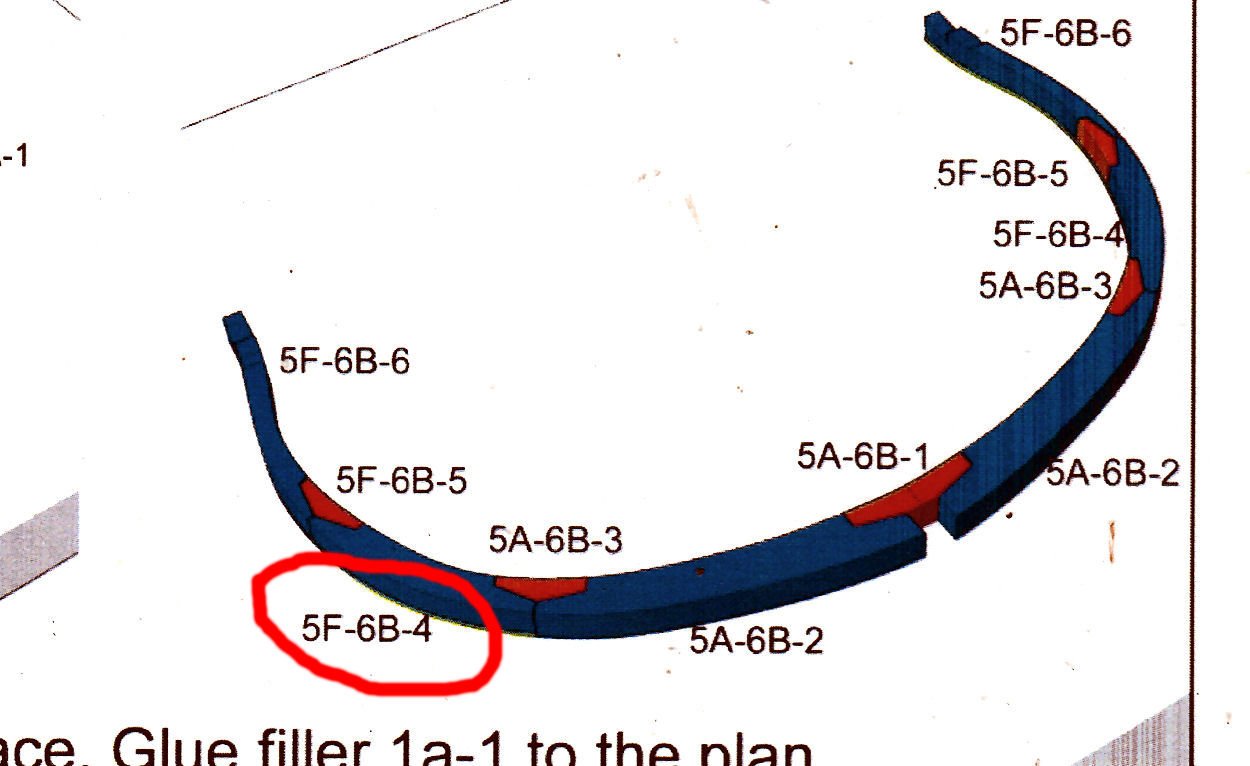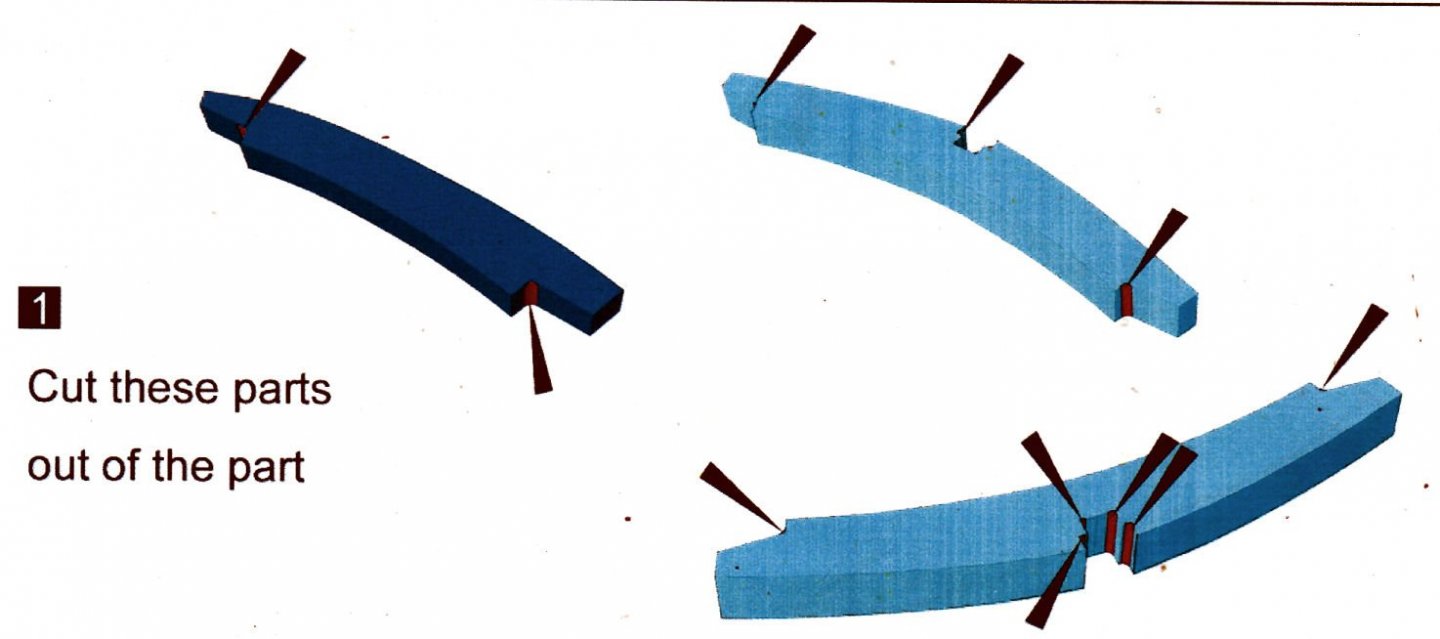-
Posts
2,928 -
Joined
-
Last visited
Content Type
Profiles
Forums
Gallery
Events
Everything posted by thibaultron
-
Part 005 Now that I have finally gotten my workshop back into some semblance of order, I got back to the Granado! I bought a new work bench from Home Depot that cranks up and down. Removing the Harbor Freight work bench I’d just installed, took some work. I started by mounting the frame drawing from the last part of the build onto the circular butcher block disk, and taped a piece of sand paper to the paper to use for sanding pieces, as needed. The first thing I found was that the butcher block was much too tough to insert pins into! So back to the drawing board. I bought a piece of ¼” X 4” x 24” basswood from Hobby Lobby, to use as a pin pad. I found some ½” cove molding in my shop, and framed the new “Pin Friendly” area with it. The area is 11 ½” x 8”. In retrospect, I should have gone with 11 ¾”. Just to allow for a little more area for the non-paper side of the hold down tape. I started with the bottom piece of the cove molding, cut to 12 ½”. The only finish nails I had in the shop were #6 x 2” ones, so I used those. #4 would have been better. I predrilled the molding in three places, using a 5/64” drill. The molding was put in place, and the first nail hole drilled into the base, then the molding itself was drilled out with a 3/32 drill. With the first nail temporarily installed I drilled the other two holes, in the same manner. I then removed the molding applied glue, and reinstalled it. Next a piece of molding about 7 ½” long was attached in the same way on one side, using a square. I cut it to 7 ½” instead of 8” for two reasons. The first was that it allowed a little wiggle room , if the basswood was not quite 4” wide, or I cut the molding too long. The second was so I have someplace to get under the basswood, in the future, when I need to replace it, due to too many pin holes. I cut the basswood in half, then clamped the two pieces together, and cut both at the same time, to insure that they were the same length. With the first two molding pieces in place, I placed the basswood on the base, and installed the top 12 ½” top piece tight against the basswood pieces. After gluing the top piece on I cleaned up the glue seepage, and allowed a few minutes for the seepage area to dry. Now with the basswood reinstalled, I installed the right hand side piece, again tight against the basswood. Once again I cleaned up seepage after gluing the last piece of molding, and allowed some drying time. At this point the base and frame looked like this. This picture shows the basswood temporarily installed to test the fit. Next I used a Dremel cutoff wheel to trim the protruding nails and cut and filed the ends of the molding to match the curve of the side pieces. Next I cut the top of the ½” molding down to level or slightly below the top of the basswood, when installed. If I had been thinking, I should have run the molding through the saw, to trim this, before I started! A sharp chisel did the honors though. Then I sanded the cuts with a sanding block. Next I installed the basswood. Due to pushing the molding tightly against the blanks, when installing the molding, the basswood pieces are held in place by friction, so I can pry them out for replacement, in the future. The frame sheet was then retaped in place, and I could finally start frame 6! The basswood holds the pins well. ½” basswood might be better, but Hobby Lobby only had 3” wide pieces of that in stock. I’ll have to be a little more careful with the fit of the parts in the future, as the camera shows the parts are not as well fitted as I thought when I glued the parts together. After I finish this frame, I’m going to run the round base through my table saw, and cut off the bottom of the round, even with the molding, this will allow me to get the base closer to the table edge, when working on the frames. This setup should work for many future models, as well as this one, and will be a basis for a future building board for my balsa, and Model Expo plane kits.
- 38 replies
-

Hull repairs
thibaultron replied to bluenose2's topic in Building, Framing, Planking and plating a ships hull and deck
If you can provide a picture, so we can better see what is going on. -
Model Railroaders swear on phosphor bronze over brass wire, It bends without anealing, and is not brittle like brass wire can be. It is used for handrails and grab irons. I have no idea if it can be blackened, but it does take paint well.
-

Squadron is being resurrected .......
thibaultron replied to yvesvidal's topic in Plastic model kits
Yaa!!! -
Could you post a link to his site, a Google search has far to many other Seahorse references.
- 24 replies
-

Trumpeter Scharnhorst Battlecruiser 1/200 is coming soon.
thibaultron replied to yvesvidal's topic in Plastic model kits
Chris, at least with a broken leg, you can get a head start on escaping your wife! -
I 'll be watching. Too bad about the plans.
- 20 replies
-
- Breezin Thru
- Wye River Models
-
(and 1 more)
Tagged with:
-
Maybe it depended on which side he was able to take the lines off of.
-
Your welcome.
-
-
Check out this guy's site. He models cars and Gundums, and has videos on all types of modeling paint reviews. https://www.youtube.com/channel/UC_66OBQNO8jXkHjlxnnxT-A
-
The glass sheet I originally had the drawing taped to is a thick (~10"X 3 foot) plate glass shelf, I found at a thrift store. I wish I'd had the money to buy the other ten or so they had!
- 38 replies
-
Part 004 Got a little accomplished today. I took the weights off the frame sheet, and the shims had glued down nicely. To prevent the frame pieces from sticking to the shims and frame sheet, I was going to used wax paper, but decided that it was both too thick, and opaque, for the job. Instead I used Scotch tape. First I put a long piece the length of each shim, then cut carefully around the bottom of the shims, pushing the tape end down onto the paper, covering the area that the chucks will sit down on. Then I covered the rest of the bottom of the frame area, leaving a good length sticking up on the ends. I then cut across where the bottom tape crossed over the pieces left from covering the shims. Then, I pulled the cut ends off, leaving only a short area where the taped was double thickness. I noticed that the sheet was not completely flat near the top, so I placed a weight across that area. The parts numbering was a bit confusing, at first, until I examined the parts sheets. 5F-6B4- For instance translates as, Parts Sheet 5F part 6B-4, as shown in the parts diagrams in the book. This picture also shows one of the reasons I scanned the instructions. As I find and remove the parts, I highlight them. As I progress, this will make finding the parts easier, by process of elimination. It will also, hopefully prevent me from ending up with parts left over, when I finish! I still have to cut out the rounded areas left when the parts were CNC routed, so I’ve only cut out the three parts highlighted. I have to figure out how to mount my lighted magnifier lamp “eyes” to the new work bench, as I had to leave off the built in vise at the right hand end, now that the spray booth sits there. The workbench top is too thick, to mount the factory “C” clamp. I’m using a second compartmented box, like the one I put the small parts in , to store the frame pieces, while I’m assembling them, or when I finish for the day. After some consideration I decided that I needed to be able to pin the frame sections in place while the glue dries, so I need to move the frame drawing from the glass plate to a wood base. I did not have any wood that was flat enough for my satisfaction, so I needed to buy another piece. The best type of wood to insure flatness, is butcher block types. I went to Home Depot, and found a 17.5”X 1” thick disk butcher block piece. Even then most of them were far from flat. I went through them and only found three of a dozen or so, that were close to flat. I selected the one that was the flattest, and bought that one. It is still a little bowed, but very close to dead flat, and close enough for this application. So I transferred the frame drawing from the glass to the disk. I also bought a short MDF shelf, that I will cut into sections, and glue sandpaper to. This will give me nice flat surfaces to sand “stuff” on.
- 38 replies
-

Tell Me Why This Is A Bad Idea ( If it is )
thibaultron replied to Gregory's topic in Modeling tools and Workshop Equipment
The tape adds little support underneath so a strip can still be pulled down and rip the tape. Others may have better reasons. -

which table saw to get??
thibaultron replied to kronvold's topic in Modeling tools and Workshop Equipment
I would say the extended rip fence, the micrometer stop, zero clearance inserts, and miter gauge extension, as the minimum. Some blades of different tooth counts, are a definite. -
If there is no hole, use a Dremel, or similar, with cutoff disks, and attack the collet stub, until there is a hole.
About us
Modelshipworld - Advancing Ship Modeling through Research
SSL Secured
Your security is important for us so this Website is SSL-Secured
NRG Mailing Address
Nautical Research Guild
237 South Lincoln Street
Westmont IL, 60559-1917
Model Ship World ® and the MSW logo are Registered Trademarks, and belong to the Nautical Research Guild (United States Patent and Trademark Office: No. 6,929,264 & No. 6,929,274, registered Dec. 20, 2022)
Helpful Links
About the NRG
If you enjoy building ship models that are historically accurate as well as beautiful, then The Nautical Research Guild (NRG) is just right for you.
The Guild is a non-profit educational organization whose mission is to “Advance Ship Modeling Through Research”. We provide support to our members in their efforts to raise the quality of their model ships.
The Nautical Research Guild has published our world-renowned quarterly magazine, The Nautical Research Journal, since 1955. The pages of the Journal are full of articles by accomplished ship modelers who show you how they create those exquisite details on their models, and by maritime historians who show you the correct details to build. The Journal is available in both print and digital editions. Go to the NRG web site (www.thenrg.org) to download a complimentary digital copy of the Journal. The NRG also publishes plan sets, books and compilations of back issues of the Journal and the former Ships in Scale and Model Ship Builder magazines.






